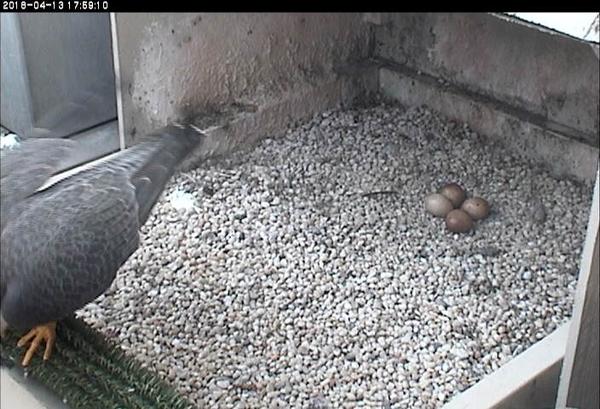
Note the “Caution” at the end of this article.
Yesterday, 13 April 2018, sharp observers saw the first pip in an egg at the Cathedral of Learning peregrine nest. I still haven’t seen it, but I’m told it’s in this picture.
This day-in-a-minute video (12 hours in 1 minute) shows that Hope and Terzo were especially active yesterday, partly due to the unusually hot weather. It was 80 degrees in the shade and hotter at the nest so it was safe to leave the eggs for a bit.
I don’t recommend watching these eggs hatch on camera. In past years Hope has killed and eaten one or more chicks as they hatch (read more here), so …
Caution! Don’t watch the eggs hatch at the Cathedral of Learning if it upsets you to see a mother kill her young.
It will be safe to watch after hatching is done. Meanwhile, I’ll keep you posted.
UPDATE on SATURDAY APRIL 15, 4:00pm: I still can’t see a pip — and neither does Pitt Peregrines on Facebook. As of this writing there is still no hatching. We’ll just have to wait…
(photos and video from the National Aviary falconcam at University of Pittsburgh)
Hi Kate! Hey, how did you get the video to play continuous? On the site, it stops every 5 minutes & you have to click to refresh. Thanks!
ps. But appreciate you putting the video up so we can check on what has happened throughout the day. Will you continue to post the days video’s? Thanks!
candi, I will post a timelapse video occasionally, not every day.
candi, here are tips for viewing the falconcams this year.
Yes, they do timeout. The reason why this happens is explained on the Aviary webpage where you view the webcam. Scroll down to see.
Thank you Kate! Yes, I know the streaming cam on the Aviary site now stops every 5 minutes & you have to click on it to restart it. But in your video, it looks like its continuous for the whole 12 hours. Did you sit there & click every 5 minutes that day to make the video above? Or how where you able to get it to play for the 12 hours? Thanks again!
candi, the day-in-a-minute video tool is not available to the public. I provide tech support for the National Aviary’s falconcams(*) so I have access to administrative tools and images. I don’t access those tools every day.
(* tech support: I’ve been doing tech support for the falconcams since 2003. I’ve helped purchase them and I troubleshoot them. Here’s some history: WESA: Why I’m Addicted to Nestcams)
My thought on Hope killing her hatchling- she has the eggs early and while the weather has been extremely cold- if the eggs froze it could damage the the inside making the hatchling to be not in excellent health and she must realize that and dispose of it while at the same time replenishing her calcium or whatever her body needs.
determined by : Having seen the eggs covered with snow and the cold winds blowing into the nest- my thoughts only
I agree with you Ev. They say this happens out in the wild. The falcon knows what it’s doing.
Ohhh, ok! I see. Thank you for explaining Kate. & thanks for the link to your “Why I’m addicted to Nestcams” link. That’s very interesting. Thank you again!!
Deb
I agree with you Ev. I was told they do this in the wild. Hope knows what she is doing.